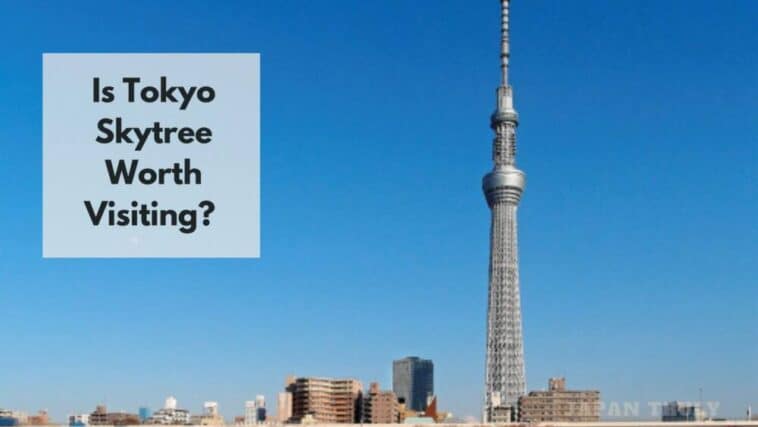Wondering is Tokyo Skytree worth it? After visiting Tokyo Skytree myself, I can tell you that Tokyo Skytree is definitely worth the visit. Read on to find out why!
Tokyo Skytree is worth the visit due to its unparalleled panoramic views of Tokyo’s dynamic cityscape.
Its unique architectural blend of tradition and innovation, coupled with its role as a cultural symbol, adds depth to the experience.
The Solamachi shopping mall offers diverse shopping and dining options, complementing the adventure. Witnessing Tokyo’s skyline transition from day to night is an enchanting spectacle.

Whether you’re drawn to modern architecture, cultural exploration, or simply capturing stunning vistas, Tokyo Skytree offers a captivating and multifaceted experience that showcases the essence of Tokyo’s vibrant urban life.
This guide dives into the captivating architecture, cultural significance, and entertainment options that make Tokyo Skytree a top attraction.
Page Contents
Is Tokyo Skytree Worth It?
Tokyo Skytree is undeniably worth a visit for those seeking a captivating blend of modern architecture, panoramic views, and cultural significance.
As the world’s tallest tower, it offers unparalleled vistas of Tokyo’s sprawling cityscape, including the chance to spot Mount Fuji on clear days.
The tower’s intricate design, a fusion of traditional Japanese aesthetics and cutting-edge engineering, adds to its allure, especially when illuminated after sunset.
The cultural symbolism embedded in its name and its juxtaposition against historic Asakusa enrich the experience.
Why is Tokyo Skytree Worth The Visit?
Tokyo Skytree Is Worth The Visit For Its Spectacular Architecture and Sky-High Views
One of the primary reasons visitors flock to Tokyo Skytree is for its breathtaking panoramic views of the city.
From its observation decks, situated at 350 meters and 450 meters above ground, visitors are treated to an unparalleled vista of Tokyo’s sprawling metropolis, encompassing both traditional and modern elements.
On clear days, you can even catch a glimpse of Mount Fuji in the distance, adding an extra layer of allure to the experience.
The architecture itself is a sight to behold. Designed with a blend of traditional Japanese aesthetics and modern engineering, Tokyo Skytree stands as a testament to the country’s harmonious balance between the past and the future.
The intricate lattice-like exterior and the fusion of glass and steel materials make for a visually captivating structure, especially when illuminated at night.
- Related: Is Tokyo Disneyland Worth It?
The Cultural Significance and Symbolism Makes Tokyo Skytree A Must-visit
Beyond its physical attributes, Tokyo Skytree also holds cultural significance. The tower’s name, “Skytree,” is a play on words that combines the image of a majestic tree reaching for the sky with the technology of communication.
This reflects Japan’s desire to stay connected globally while remaining rooted in its traditions.
For those interested in symbolism, the Tokyo Skytree embodies the concept of “asakusa” and “shitamachi,” representing both old and new Tokyo.
The tower stands not far from Asakusa, an area known for its historic temples and traditional ambiance. This juxtaposition of modernity against a backdrop of heritage adds depth to the Skytree’s appeal.
Visit Tokyo Skytree For Its Entertainment and Shopping
The Tokyo Skytree complex offers a diverse range of entertainment and shopping experiences, adding an extra layer of appeal to your visit. Here’s a more detailed exploration of what you can expect in terms of entertainment and shopping at Tokyo Skytree:
- Solamachi Shopping Mall: The Solamachi shopping mall is a bustling hub of activity located at the base of Tokyo Skytree. It’s a sprawling complex that spans over several floors, each filled with a wide variety of shops, restaurants, and entertainment options.
Here’s what you can find:
- Shopping: Solamachi boasts a rich collection of stores catering to different tastes. From high-end fashion boutiques to quirky Japanese pop culture shops, you’ll find a diverse range of options for clothing, accessories, electronics, and more.
- Souvenirs and Crafts: If you’re looking for unique Japanese souvenirs, this is the place to be. Traditional crafts, local snacks, and beautifully designed items make for perfect keepsakes from your trip.
- Anime and Pop Culture: A treat for fans of Japanese anime and pop culture, Solamachi has dedicated stores filled with merchandise from popular anime, manga, and gaming franchises. It’s a paradise for collectors and enthusiasts.
Dining and Cuisine
Tokyo Skytree offers an extensive selection of dining establishments that cater to a wide range of palates. You can savor traditional Japanese cuisine, international dishes, and fusion creations.
The dining options range from casual cafes to upscale restaurants, ensuring that you’ll find something to satisfy your cravings.
Sumida Aquarium
Within the Tokyo Skytree complex, you’ll also find the Sumida Aquarium. While it’s not directly inside the tower, it’s conveniently located nearby.
This unique and artistic aquarium showcases marine life from Tokyo Bay, and its innovative exhibits aim to evoke a sense of wonder and connection with the underwater world.
Observation Deck Attractions
While the primary allure of the Tokyo Skytree’s observation decks is the stunning view, there are additional attractions that enhance the experience:
- Skytree Cafe: Enjoy a cup of coffee or a light meal while soaking in the breathtaking views. The cafe’s location on the observation deck adds an element of luxury to your visit.
- Skytree Terrace: Step outside onto the open-air Skytree Terrace for a refreshing change of perspective. The terrace offers a unique opportunity to feel the breeze at such heights and capture stunning photos.
In essence, the entertainment and shopping options at Tokyo Skytree cater to a wide range of interests.
Whether you’re a fashion enthusiast, a pop culture lover, a foodie, or someone looking to explore marine life, there’s something for everyone.
The combination of shopping, dining, and attractions creates an atmosphere that invites visitors to immerse themselves in a vibrant blend of modern Japanese culture and innovation.
However, it’s important to keep in mind that these experiences come at a cost, both in terms of time and money, so it’s advisable to plan your visit according to your interests and priorities.
Is Skytree or Tokyo Tower better?
Tokyo Skytree, as the world’s tallest tower, offers unparalleled panoramic views of the city, showcasing Tokyo’s modern and historic elements.
Its intricate design and cultural significance, along with the entertainment and shopping complex, provide a comprehensive experience, particularly for those interested in modern architecture, technology, and a vibrant urban atmosphere.
On the other hand, Tokyo Tower holds its own charm as a beloved symbol of Tokyo. While not as tall as Skytree, it boasts a classic design and a history that dates back decades.
Tokyo Tower’s two observation decks offer views of the city, albeit from a lower height, and its close proximity to Shiba Park and Zōjō-ji Temple allows for a more integrated experience with historical and natural surroundings.
Ultimately, if you prioritize modernity, cutting-edge design, and immersive entertainment, Tokyo Skytree might be more appealing.
If you’re interested in a blend of history, iconic architecture, and a classic Tokyo experience, Tokyo Tower could be the better choice.
Both offer unique perspectives on the city, so the “better” option comes down to your personal interests and the kind of experience you’re seeking.
Why is Tokyo Skytree a good place to visit?
Tokyo Skytree is a compelling destination for several reasons, making it a standout attraction for visitors to Tokyo.
First and foremost, its status as the tallest tower globally grants unparalleled panoramic views of Tokyo’s urban landscape.
From its observation decks, visitors can witness a mesmerizing blend of traditional neighborhoods and modern skyscrapers, providing a comprehensive understanding of the city’s unique character.
The architectural brilliance of Tokyo Skytree also contributes to its appeal. Its design is a fusion of traditional Japanese aesthetics and cutting-edge engineering, offering a captivating visual experience both inside and out.
The tower’s symbolic name, signifying both a majestic tree reaching for the sky and communication technology, adds cultural depth to the visit.
Additionally, the Skytree complex encompasses an array of entertainment and shopping options.
The Solamachi shopping mall hosts an assortment of stores catering to various tastes, from traditional crafts to contemporary pop culture. The diverse dining scene allows visitors to savor a range of cuisines.
Overall, Tokyo Skytree offers an all-encompassing experience: stunning views, innovative architecture, cultural significance, and an immersive entertainment environment.
It’s a testament to Japan’s ability to seamlessly blend its rich heritage with modern advancements, making it a must-visit for anyone seeking a quintessential Tokyo experience.
Is Shibuya Sky better than Tokyo Skytree?
Deciding between Shibuya Sky and Tokyo Skytree depends on the type of experience you’re seeking.
Shibuya Sky, located in the heart of the bustling Shibuya district, offers a unique urban perspective.
It provides captivating views of iconic landmarks like Shibuya Crossing and the surrounding vibrant cityscape. The location’s energetic ambiance, especially during the evenings, adds to its appeal.
It’s an excellent choice for those who want to immerse themselves in Tokyo’s urban buzz and witness the city’s famous scramble crossing from above.
On the other hand, Tokyo Skytree’s height and design grant a broader panorama of Tokyo’s expansive cityscape.
It showcases a mix of traditional and modern elements, providing a comprehensive view that spans from historic neighborhoods to contemporary skyscrapers.
Tokyo Skytree also offers an entertainment and shopping complex, adding depth to the visitor experience.
Ultimately, whether Shibuya Sky is better than Tokyo Skytree depends on your priorities. If you’re captivated by urban energy and want a closer connection to iconic Shibuya, Shibuya Sky could be the preferred choice.
However, if you’re seeking a comprehensive and panoramic view that also includes cultural and architectural depth, Tokyo Skytree’s higher elevation and broader range of offerings might be more appealing.
Can you see Mt. Fuji from Tokyo Skytree?
Yes, on clear days, it’s possible to see Mount Fuji from the Tokyo Skytree’s observation decks.
Mount Fuji, Japan’s highest and most iconic peak, is located approximately 100 kilometers southwest of Tokyo. Due to its considerable distance, weather conditions play a crucial role in visibility.
When the weather is clear and the sky is not hazy, visitors on the observation decks of Tokyo Skytree, especially the higher deck at 450 meters, might be lucky enough to catch a glimpse of Mount Fuji in the distance.
How long can I stay in Tokyo Skytree?
Generally, visitors spend around 1 to 2 hours exploring the observation decks, taking in the views, enjoying the attractions, and shopping at the Solamachi complex.
However, if you plan to dine in one of the restaurants or explore the entertainment options more extensively, your visit might extend to around 3 hours or more.
It’s recommended to allocate enough time to fully appreciate the experience without feeling rushed, especially if you’re interested in capturing different views of Tokyo during daylight and at night.
What’s the best time to go to Tokyo Skytree?
The best time to visit Tokyo Skytree is during the late afternoon to early evening. Arriving a couple of hours before sunset allows you to experience the breathtaking panoramic views both in daylight and as the city lights up after dark.
This timing provides a seamless transition from daytime to nighttime vistas. Additionally, weekdays generally have fewer crowds compared to weekends.
However, for the clearest views and the possibility of seeing Mount Fuji, choosing a day with clear weather is essential. Remember to check the weather forecast and consider making a reservation to avoid long lines during peak hours.
What do people do in Tokyo Skytree?
Visitors to Tokyo Skytree engage in a range of activities. They ascend the tower’s observation decks, located at 350 meters and 450 meters, to marvel at panoramic views of Tokyo’s cityscape, capturing photos and enjoying the skyline both during the day and illuminated at night.
Exploring the Solamachi shopping mall offers shopping for traditional crafts, anime merchandise, and fashion. Dining options cater to various tastes, and visitors often indulge in Japanese and international cuisine.
The complex also houses the Sumida Aquarium for marine enthusiasts. Overall, Tokyo Skytree offers a blend of sightseeing, shopping, dining, and cultural experiences for a diverse range of interests.
Can you eat in Tokyo Skytree?
Yes, you can definitely eat at Tokyo Skytree. The complex offers a variety of dining options to suit different tastes and preferences.
From casual cafes to more upscale restaurants, visitors can enjoy Japanese cuisine, international dishes, and fusion creations.
Whether you’re looking for a quick snack, a leisurely meal, or a cup of coffee while taking in the views, there are plenty of choices available.
The dining establishments are situated within the Solamachi shopping mall, making it convenient for visitors to enjoy a meal or refreshments during their time at Tokyo Skytree.
Do you need to book Tokyo Skytree in advance?
While it’s not always necessary to book Tokyo Skytree tickets in advance, doing so can save you time and help you avoid long lines, especially during peak tourist seasons.
If you have a specific date and time in mind for your visit, booking online or through designated ticketing platforms can ensure availability and a smoother experience.
However, if you’re flexible with your schedule, you can also purchase tickets on-site at the ticket counter.
Keep in mind that certain packages or special events might have limited availability, so advanced booking can be beneficial for securing your preferred experience.
Is Tokyo Skytree good at night?
Yes, Tokyo Skytree is especially captivating at night. The tower’s intricate lattice-like exterior is illuminated, creating a mesmerizing and futuristic glow against the night sky.
The observation decks offer a stunning panoramic view of Tokyo’s city lights, which twinkle like stars. The city’s neon signs, illuminated streets, and landmarks create a vibrant tapestry of colors.
Tokyo’s skyline takes on a different charm after dark, and the combination of the tower’s design and the city’s illumination make a nighttime visit to Tokyo Skytree a truly memorable experience for visitors seeking a unique perspective on the city.
Here’s all the important information to know before you visit Tokyo Skytree
| Information | Details |
| Location | 1 Chome-1-2 Oshiage, Sumida City, Tokyo 131-0045, Japan |
| Opening Hours | 8:00 AM – 10:00 PM (last admission at 9:00 PM) |
| Ticket Options | Various ticket packages for different decks and age groups |
| Advanced Booking | Recommended, especially for specific dates and times |
| Peak Hours | Weekends, holidays, and evenings can be busier |
| Best Time to Visit | Late afternoon to early evening for day-to-night views |
| Sunset Views | Arrive a couple of hours before sunset for a seamless transition |
| Dining and Shopping | Solamachi shopping mall offers diverse dining and shopping |
| Observation Decks | Two decks at 350 meters and 450 meters |
| Additional Attractions | Skytree Terrace, Sumida Aquarium, Skytree Cafe |
| Weather Consideration | Clear days offer better visibility for views and Mt. Fuji sighting |
| Getting There | Easily accessible via public transportation |
| Proximity to Asakusa | Close to historic Asakusa for a cultural complement |
| Recommended Duration | About 1.5 to 3 hours, depending on interests |
Conclusion
In the end, whether Tokyo Skytree is worth it depends on what you seek in your travel experience.
For those yearning to see Tokyo from a unique perspective, immerse themselves in modern Japanese architecture, and embrace a blend of tradition and innovation, a visit to Tokyo Skytree is undeniably rewarding.
However, if your interests lie more in exploring historical sites and cultural nuances, there are equally captivating options throughout Tokyo that might suit your preferences better.
My writing focuses on the various aspects of Japanese lifestyle, from traditional tea ceremonies and flower arrangement to modern fashion trends and pop culture. Through my articles, I aim to share my passion for Japan and provide readers with a glimpse into the rich and diverse world of Japanese culture.
I believe that the key to understanding Japanese lifestyle is to appreciate the balance between tradition and innovation. While Japan has a rich cultural heritage that dates back centuries, it is also a country that is constantly evolving and embracing new ideas and technologies.
Whether you’re interested in learning about the latest fashion trends in Tokyo, or want to explore the ancient art of calligraphy, my writing will take you on a journey through the many facets of Japanese lifestyle. So join me as we explore the beauty and complexity of this fascinating culture together!





